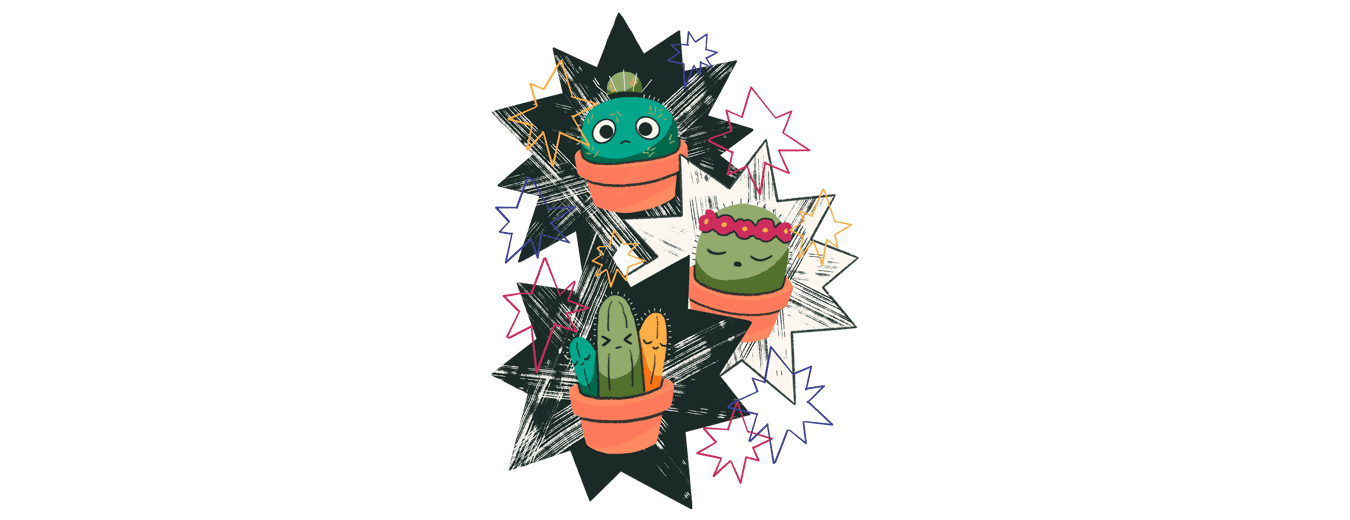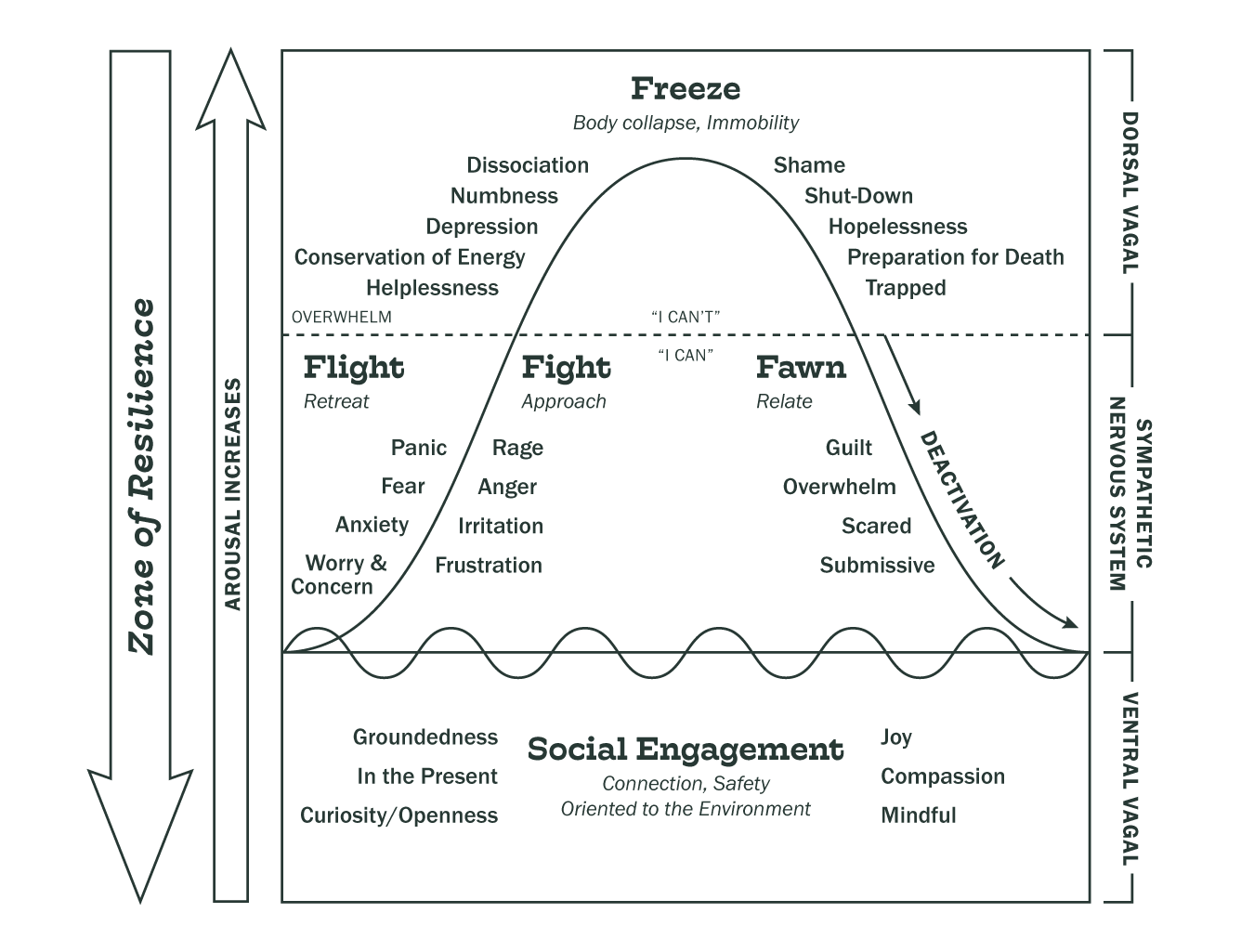Trauma Response
We are very excited to review various healing practices you can incorporate into your healing journey, but first, we want to take some time to go over trauma and the ways our bodies might respond to it.
In this section, we will explore Dr. Stephen Porges’s Polyvagal Theory¹ to deepen our own understanding of trauma. Through our nervous system (NS), we all have an innate ability to detect safety, danger, or life threat, called neuroception. Depending on our internal and external cues, we will adapt or respond to the conditions of our environment.
Three nervous system states:
- Sympathetic NS (SNS)
- Neuroception of danger.
- Stress response is activated.
- We seek safety via action. The SNS supports excitation and alertness at the low end of the activation cycle and it empowers mobilization of fight, flight, fawn at the high end.
- Parasympathetic NS (PNS) - Dorsal Vagal
- Neuroception of life threat.
- Freeze response is activated.
- We seek safety via disconnection.
- This is our most primitive response. It helps us move between arousal and relaxation. However, when the sympathetic system is overwhelmed, the emergency/freeze state will be activated.
- Parasympathetic NS (PNS) - Ventral Vagal
- Neuroception of safety.
- Relaxation response is activated.
- We seek safety via connection.
- This is a more nuanced portion of the PNS, it supports social engagement behaviors such as bonding, attachment, and appeasement.
Our NS is designed to protect us and through activation of stress hormones we can scare a predator or run away from it in the wild. Our NS has played a central role in our evolution as a species and in our ability to connect with one another. However, when a person is in a state of activation over a long period of time, dysregulation can occur with the NS function.

Adverse childhood experiences, or ACEs²,
are potentially traumatic events that occur in childhood (0-17 years). For example:
- experiencing violence, abuse, or neglect
- witnessing violence in the home or community
- having a family member attempt or die by suicide
Also aspects of the child’s environment that can undermine their sense of safety, stability, and bonding such as growing up in a household with:
- substance misuse or substance use disorders
- mental health problems
- instability due to parental separation or household members being in jail or prison
ACEs are linked to chronic health problems, mental illness, substance misuse, and substance use disorders in adulthood. ACEs can also negatively impact education and job opportunities.
The Zone of Resilience³
In everyday life we naturally flow between sympathetic and parasympathetic states. The zone of resilience is our capacity to manage life’s challenges. From this space we can navigate life with a sense of safety and confidence, even when entering new or unfamiliar territory. By doing so, we develop the self-awareness of our activations and we can apply self-regulating tools that will take us back to a rest and digest state more quickly and with less effort.
The Activation Cycle⁴
Understanding how our nervous system works is an essential part of every healing journey. The Activation Cycle is a helpful tool that can help you identify the state of your nervous system. As you continue reading through the zine, pay attention to the way you respond to the content. Your activations can help you identify the areas of your life that need more attention and/or healing.
The Activation Cycle
Adapted by Porges (2011 & 2017) & Missimer (2020)

Freeze - Emergency State
Over time this can show up as spacing out, chronic shame, stuckness, isolation, and suicidal ideation.
Physiological response:
Increases: Fuel storage ▪️ Insulin activity ▪️ Endorphins that help numb and raise pain threshold
Decreases: Heart rate ▪️ Blood pressure ▪️ Muscle tone ▪️ Eye contact ▪️ Immune response ▪️ Sexual responses
Fight
Over time this can show up as anger outbursts, controlling behavior, narcissism, and bullying others.
Flight
Over time this can show up as perfectionism, difficulty standing still, overachieving, and micromanaging situations or people.
Fawn
Over time this can show up as people pleasing, prioritizing other’s needs over one’s own, avoiding conflict, and Stockholm syndrome.
Physiological response:
Increases: Blood pressure ▪️ Heart rate ▪️ Adrenaline ▪️ Oxygen circulating to vital organs ▪️ Pupil size
Decreases: Digestion ▪️ Fuel storage ▪️ Insulin activity ▪️ Immune response ▪️ Salivation ▪️ Relational ability
Rest & Digest
Our ability to relate and connect improves.
Physiological response:
Increases: Digestion ▪️ Resistance to infection ▪️ Circulation ▪️ Immune responses ▪️ Oxytocin ▪️ Rest & recuperation
Decreases: Defensive responses
Now that we have reviewed how our environment can affect us, we will go over specific impacts that groups of people may experience based on their identity, and ways they can practice healing from them.


